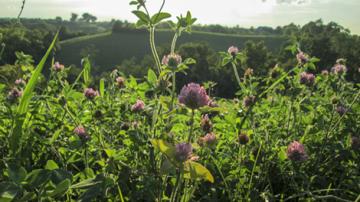Red Clover, Red Clover – Send Your Isoflavones Right Over

Red clover (Trifolium pratense) hay field. Unlike supplements, isoflavones do not need to be extracted and concentrated to use; the natural isoflavone content in red clover hay is high enough to spur weight gain and alleviate fescue toxicosis in cattle. (Michael Flythe, D4615-1)
Thanks to major clover-centric breakthroughs by the Agricultural Research Service’s (ARS) Forage-Animal Production Research Unit, we’ve found yet another reason to love clover this March.
While the four-leaf clover is a celebrated good luck charm in folk tradition, members of the genus Trifolium have long been a ‘holy grail’ for agronomists and farmers too. As natural nitrogen fixers, clovers help instill nitrogen in soil and lessen our reliance on chemical fertilizers to keep fields productive. Additionally, common varieties like red or white clover happen to be extremely palatable and can provide high quality protein to cattle at a low cost.
According to ARS microbiologist Michael Flythe, who worked with ARS plant physiologist Isabelle Kagan and ARS animal scientist Brittany Harlow to investigate potential plant-based antimicrobials, clovers are also an ideal alternative to synthetic bactericides used in cattle feed. The two discovered that clover could effectively reduce hyper-ammonia-producing bacteria that live in cattle rumen (the first chamber of a ruminant animal’s digestive tract).
“Hyper-ammonia-producing bacteria decrease the amount of dietary protein that an animal can absorb through digestion,” said Flythe. “Decreased dietary protein causes loss in cattle growth and overall performance. When you add clover to cattle diets, special compounds in clover called isoflavones actually improve the quality and quantity of protein available to the animals.”
The magic of clover isoflavones, which are similar to estrogen in structure, doesn’t stop there; they also give cattle an additional defense against dangers like fescue toxicosis. Caused by the consumption of common endophyte infected tall fescue, a hardy grass, fescue toxicosis is a condition that results in tightened blood vessels, fertility problems, weight loss, and lowered milk production in livestock animals. It is estimated that fescue toxicosis costs the U.S. livestock industry $2 billion annually.
“One of the reasons that common tall fescue is so abundant and resilient is actually because it contains a natural chemical defense against herbivores, which acts as a toxin when ingested,” Flythe explained. “After it builds up in the cattle, the animals become ill because their blood vessels have constricted, impeding blood flow. But when cattle consume tall fescue with clover, the isoflavones open up their blood vessels and improve blood flow.
While the cattle may be thankful for their lucky clovers, research indicates that isoflavones in clover can dilate arteries and promote healthy blood flow in humans as well. Clovers and their extracts have been used to treat migraines, increasing their potential as a natural remedy for other vasoconstrictive conditions. – by Georgia Jiang, ARS Office of Communications.

